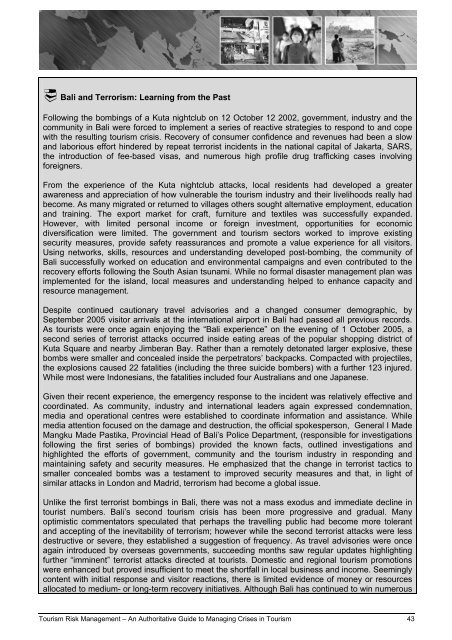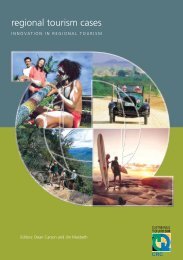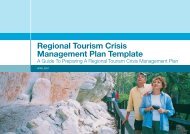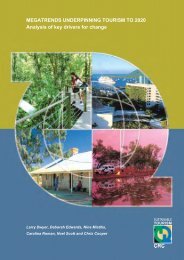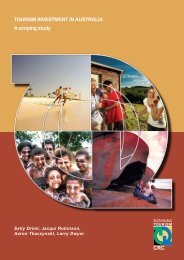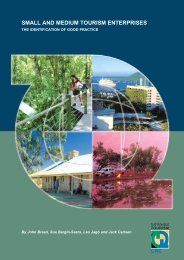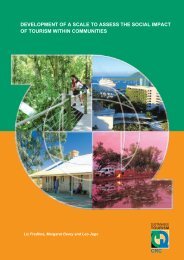Tourism Risk Management - Sustainable Tourism Online
Tourism Risk Management - Sustainable Tourism Online
Tourism Risk Management - Sustainable Tourism Online
Create successful ePaper yourself
Turn your PDF publications into a flip-book with our unique Google optimized e-Paper software.
Bali and Terrorism: Learning from the Past<br />
Following the bombings of a Kuta nightclub on 12 October 12 2002, government, industry and the<br />
community in Bali were forced to implement a series of reactive strategies to respond to and cope<br />
with the resulting tourism crisis. Recovery of consumer confidence and revenues had been a slow<br />
and laborious effort hindered by repeat terrorist incidents in the national capital of Jakarta, SARS,<br />
the introduction of fee-based visas, and numerous high profile drug trafficking cases involving<br />
foreigners.<br />
From the experience of the Kuta nightclub attacks, local residents had developed a greater<br />
awareness and appreciation of how vulnerable the tourism industry and their livelihoods really had<br />
become. As many migrated or returned to villages others sought alternative employment, education<br />
and training. The export market for craft, furniture and textiles was successfully expanded.<br />
However, with limited personal income or foreign investment, opportunities for economic<br />
diversification were limited. The government and tourism sectors worked to improve existing<br />
security measures, provide safety reassurances and promote a value experience for all visitors.<br />
Using networks, skills, resources and understanding developed post-bombing, the community of<br />
Bali successfully worked on education and environmental campaigns and even contributed to the<br />
recovery efforts following the South Asian tsunami. While no formal disaster management plan was<br />
implemented for the island, local measures and understanding helped to enhance capacity and<br />
resource management.<br />
Despite continued cautionary travel advisories and a changed consumer demographic, by<br />
September 2005 visitor arrivals at the international airport in Bali had passed all previous records.<br />
As tourists were once again enjoying the “Bali experience” on the evening of 1 October 2005, a<br />
second series of terrorist attacks occurred inside eating areas of the popular shopping district of<br />
Kuta Square and nearby Jimberan Bay. Rather than a remotely detonated larger explosive, these<br />
bombs were smaller and concealed inside the perpetrators’ backpacks. Compacted with projectiles,<br />
the explosions caused 22 fatalities (including the three suicide bombers) with a further 123 injured.<br />
While most were Indonesians, the fatalities included four Australians and one Japanese.<br />
Given their recent experience, the emergency response to the incident was relatively effective and<br />
coordinated. As community, industry and international leaders again expressed condemnation,<br />
media and operational centres were established to coordinate information and assistance. While<br />
media attention focused on the damage and destruction, the official spokesperson, General I Made<br />
Mangku Made Pastika, Provincial Head of Bali’s Police Department, (responsible for investigations<br />
following the first series of bombings) provided the known facts, outlined investigations and<br />
highlighted the efforts of government, community and the tourism industry in responding and<br />
maintaining safety and security measures. He emphasized that the change in terrorist tactics to<br />
smaller concealed bombs was a testament to improved security measures and that, in light of<br />
similar attacks in London and Madrid, terrorism had become a global issue.<br />
Unlike the first terrorist bombings in Bali, there was not a mass exodus and immediate decline in<br />
tourist numbers. Bali’s second tourism crisis has been more progressive and gradual. Many<br />
optimistic commentators speculated that perhaps the travelling public had become more tolerant<br />
and accepting of the inevitability of terrorism; however while the second terrorist attacks were less<br />
destructive or severe, they established a suggestion of frequency. As travel advisories were once<br />
again introduced by overseas governments, succeeding months saw regular updates highlighting<br />
further “imminent” terrorist attacks directed at tourists. Domestic and regional tourism promotions<br />
were enhanced but proved insufficient to meet the shortfall in local business and income. Seemingly<br />
content with initial response and visitor reactions, there is limited evidence of money or resources<br />
allocated to medium- or long-term recovery initiatives. Although Bali has continued to win numerous<br />
<strong>Tourism</strong> <strong>Risk</strong> <strong>Management</strong> – An Authoritative Guide to Managing Crises in <strong>Tourism</strong> 43


